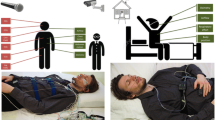Abstract
Purpose
Adverse surgical outcomes may occur more frequently in patients with sleep-disordered breathing (SDB). Despite this concern, there have been no prospective studies using objective measures of postoperative SDB to determine the scope of the problem. We designed a prospective study to determine the feasibility of identifying SDB in elective postoperative patients by the use of a type IV portable monitor (PM).
Methods
Patients >18 years old who presented for elective surgery with at least one postoperative hospital night on a non-monitored unit were enrolled and wore a type IV device that measured nasal flow, heart rate, and oxygen saturation on their first postoperative night. Respiratory disturbance index (RDI) and oxygen desaturation index (ODI) were generated for each patient.
Results
Data sufficient for interpretation were collected on 100/116 patients enrolled. SDB (RDI ≥5) was observed in 51% of the study group, and 17% had a RDI >15. An elevated ODI ≥5 was seen in 42%, while 17% had an ODI ≥15. Device malfunction occurred in 16% of the study participants.
Conclusion
A type IV PM can be employed in the postoperative setting to detect and gauge the severity of SDB.
Similar content being viewed by others
Abbreviations
- OSA:
-
Obstructive sleep apnea
- SDB:
-
Sleep-disordered breathing
- RDI:
-
Respiratory disturbance index
- AHI:
-
Apnea hypopnea index
- ODI:
-
Oxygen desaturation index
- CPAP:
-
Continuous positive airway pressure
- BMI:
-
Body mass index
- MEND:
-
Morphine equivalent narcotic dose
References
American Society of Anesthesiologists Task Force on Perioperative Management of Obstructive Sleep Apnea (2006) Practice guidelines for the perioperative management of patients with obstructive sleep apnea: a report by the American Society of Anesthesiologists Task Force on Perioperative Management of patients with obstructive sleep apnea. Anesthesiology 104:1081–1093
Kaw R, Michota F, Jaffer A, Ghamande S, Auckley D, Golish J (2006) Unrecognized sleep apnea in the surgical patient: implications for the perioperative setting. Chest 129:198–205
Iber C, Ancoli-Israel S, Chesson A, Quan SF, American Academy of Sleep Medicine (2007) The AASM manual for the scoring of sleep and associated events: rules, terminology and technical specifications, 1st edn. American Academy of Sleep Medicine, Westchester
American Academy of Sleep Medicine Task Force (1999) Sleep-related breathing disorders in adults: recommendations for syndrome definition and measurement techniques in clinical research. Sleep 22:667–689
Punjabi NM (2008) The epidemiology of adult obstructive sleep apnea. Proc Am Thorac Soc 5:136–143
Stierer TL, Wright CW, George A, Thompson RE, Wu CL, Collop N (2010) Risk assessment of obstructive sleep apnea in a population of patients undergoing ambulatory surgery. J Clin Sleep Med 6(5):467–472
Chung F, Yegneswaran B, Liao P, Chung SA, Vairavanathan S, Islam S, Khajehdehi A, Shapiro CM (2008) STOP questionnaire: a tool to screen patients for obstructive sleep apnea. Anesthesiology 108:812–821
Liesching TN, Carlisle C, Marte A, Bonitati A, Millman FP (2004) Evaluation of the accuracy of SNAP technology sleep sonography in detecting obstructive sleep apnea in adults compared to standard polysomnography. Chest 125:886–891
Chesson AL, Berry RB, Pack A (2003) Practice parameters for the use of portable monitoring devices in the investigation of suspected obstructive sleep apnea in adults. Sleep 26:907–913
Skomro RP, Gjevre J, Reid J, McNab B, Ghosh S, Stiles M, Jokic R, Ward H, Cotton D (2010) Outcomes of home-based diagnosis and treatment of obstructive sleep apnea. Chest 138:257–263
Disclosure
There is no financial support, conflict of interest, and off-label or investigational use to disclose.
Author information
Authors and Affiliations
Corresponding author
Rights and permissions
About this article
Cite this article
Weir, I.D., Ahmed, K.M., Korbuly, S. et al. Detection of postoperative sleep-disordered breathing using a portable monitoring device. Sleep Breath 16, 881–886 (2012). https://doi.org/10.1007/s11325-011-0590-1
Received:
Revised:
Accepted:
Published:
Issue Date:
DOI: https://doi.org/10.1007/s11325-011-0590-1




